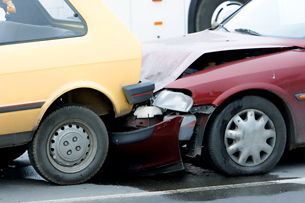Module 2
1. Module 2
1.3. Lesson 1
Module 2—The Conservation of Momentum in Isolated Systems
Lesson 1—Linear Collisions and the Conservation of Momentum

©Aleksandar Kamasi/shutterstock
 Get Focused
Get Focused
It is obvious that this photo shows a rear-end collision. The vehicles collided along a straight line—a linear collision.
During the collision, the momentum of each of the cars involved changed, and forces acted over time to provide an impulse to each car. These interactions are complicated; the forces not only changed the momentum of each vehicle, the forces also changed the shape of each vehicle. It is worthwhile to analyze interactions like this not only to determine who was responsible from a legal point of view, but also to improve the design of vehicles to reduce injuries to the occupants.
momentum: the product of the mass and velocity of an object
In this lesson you will explore linear collisions in the context of the following questions:
-
Can the complicated details of a linear collision be eliminated during the analysis of an interaction?
-
What is the law of conservation of momentum, and how can it be used to answer the previous question?
-
Under what circumstances can this law be applied?
 Module 2: Lesson 1 Assignments
Module 2: Lesson 1 Assignments
Your teacher-marked Module 2: Lesson 1 Assignment requires you to submit a response to the following:
- Lab—LAB 1, LAB 2, and LAB 3
-
Assignment—A 1, A 2, and A 3
-
Discuss—D 5
Although the other questions in this lesson will not be marked by the teacher, you should still answer these questions. The Self-Check and Try This questions are placed in this lesson to help you review important information and build key concepts that may be applied in future lessons.
After a discussion with your teacher, you must decide what to do with the questions that are not part of your assignment. For example, you may decide to submit to your teacher the responses to Try This questions that are not marked. You should record the answers to all the questions in this lesson and place those answers in your course folder.
You will also begin your Module 2 Project. You will start working on a Crash Analysis, which you will save to your Physics 30 course folder and submit to your teacher for marks when you have finished Module 2.